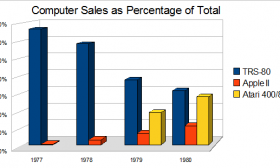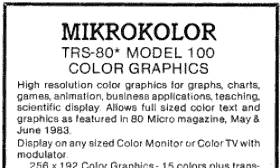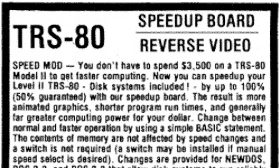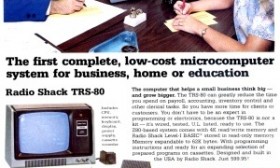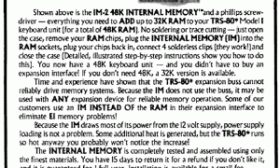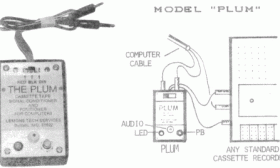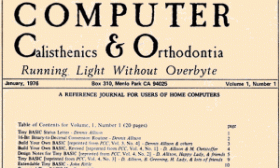The Mikrokolor Color Graphics Interface
The Mikrokolor was a color graphics interface for the TRS-80 Model 100 that was sold by Andreasen’s Electronics Research & Development, Inc. The Mikrokolor hardware was designed by Paul Andreasen, the digital interface and graphics routines created by James Cole, and the software written by Andrew Baird. Andreasen’s Electronics Research & Development also sold versions of the Mikrokolor for the Model I, Model III, Model 4, and Model 12 and also the S-100 bus and the Apple II. There was also a $54.00 VHF modulator for the Mikrokolor that operated on channels 7 to 10.
The Mikrokolor fit into much the same category as the later Disk/Video Interface sold by Radio Shack, allowing a Model 100 to be used with a separate monitor. Unlike the Disk/Video Interface, which was black and white only, the Mikrokolor displayed in color.
The Archbold Speedup Board
The TRS-80 Model I ran at a speed of 1.77 MHz. That speed was quite fast for a microcomputer at the time, but almost immediately people began designing speedup boards to increase it. The most famous of those speedup boards was the Archbold Speedup Board, designed by Bill Archbold and sold by Archbold Electronics.
The Archbold Speedup Board itself was a fairly small board (1.5" by 2.5"). It came with an instruction manual containing complete installation directions, including a photo of the Model I logic board. The exact installation procedure varied depending on the hardware installed but involved soldering wires to various points within the Model I and cutting a few traces.
Level I BASIC
When the TRS-80 Model I was first released in 1977, the BASIC interpreter that Microsoft was writing, Level II BASIC, was still months away from completion. Instead the Model I originally shipped with a BASIC interpreter known as Level I BASIC.
Level I BASIC was based on “Palo Alto Tiny BASIC”, a 2K version of Tiny BASIC written by Dr. Li-Chen Wang for the May 1976 issue of Dr. Dobb’s Journal. Because Dr. Li Chen-Wang placed his BASIC in the public domain (he labeled it “@COPYLEFT; ALL WRONGS RESERVED”), Steve Leininger, the designer of the TRS-80, was able to use it as a starting point. He added floating point math, cassette, keyboard, and video routines, doubling the size of the original code to 4K.
The Holmes Internal Memory
Although the TRS-80 Model I supported up to 48K of memory, there were only sockets for 16K within the Model I itself. The only official way to add more memory was to buy the Radio Shack Expansion Interface, which had sockets for an additional 32K of memory, for 48K in total. The Expansion Interface (without any memory) cost $299.00, making any kind of official memory expansion very expensive.
The other important feature of the Expansion Interface was the built-in floppy disk controller. But not everyone was interested in or could afford floppy drives, which cost hundreds of dollars per drive. Many people used cassettes or other alternative storage devices, such as the Exatron Stringy Floppy, the TC-8, or the BETA-80. What option was there for the Model I user who wanted to maximize memory but without the extras (and expense) of the Expansion Interface?
One answer was the Internal Memory, introduced by Holmes Engineering in 1981. Designed by Larry Holmes, the Internal Memory added memory entirely inside the Model I without requiring an Expansion Interface. It could be easily installed by the user without any soldering or trace cutting. The Internal Memory came in three versions:
The Radio Shack "expansion box"
The TRS-80 Model I was designed to allow for external expansion through what Steve Leininger described as an “expansion port” (the TRS-80 card edge connector). Many people assumed that Radio Shack was developing a S-100 based expansion box to attach to the Model I. (The S-100 was a popular bus standard at the time.)
The first issue of the Radio Shack Microcomputer Newsletter in late 1977 contained a section answering some common questions about the new TRS-80 computer. One answer gave some details about the upcoming “expansion box”:
No-Fuss Any-Speed Hardware – The Cassette Gazette Page 14
The Cassette Gazette was a 1983 one issue advertising newsletter that was a joint production of Lemons Tech and KWIK Software. The Gazette described the products sold by the two companies, mixed in with operational advice and interesting facts about using cassettes with your TRS-80. It appears to have been written by Wayne Lemons, the founder of Lemons Tech. The Gazette is reproduced here page by page with permission from Wayne Lemons’ family.
TRS-80 Cassette Software – The Cassette Gazette Page 13
The Cassette Gazette was a 1983 one issue advertising newsletter that was a joint production of Lemons Tech and KWIK Software. The Gazette described the products sold by the two companies, mixed in with operational advice and interesting facts about using cassettes with your TRS-80. It appears to have been written by Wayne Lemons, the founder of Lemons Tech. The Gazette is reproduced here page by page with permission from Wayne Lemons’ family.
Dr. Dobb's Journal
Dr. Dobb’s Journal was one of the longest running microcomputer magazines, lasting 33 years in print form. It was first published in January 1976 as Dr. Dobb’s Journal of Computer Calisthenics & Orthodontia with the subtitle “Running Light Without Overbyte”. The title of the magazine was eventually shortened to Dr. Dobb’s Journal.
The name “Dr. Dobb” didn’t refer to a real person but was created by combining the first names of Bob Albrecht and Dennis Allison, the founders of the magazine. The magazine was originally created to promote the concept of Tiny BASIC, a small but powerful BASIC interpreter that could be used on the new microcomputers such as the Altair.
Integrated Tape – The Cassette Gazette Page 12
The Cassette Gazette was a 1983 one issue advertising newsletter that was a joint production of Lemons Tech and KWIK Software. The Gazette described the products sold by the two companies, mixed in with operational advice and interesting facts about using cassettes with your TRS-80. It appears to have been written by Wayne Lemons, the founder of Lemons Tech. The Gazette is reproduced here page by page with permission from Wayne Lemons’ family.
